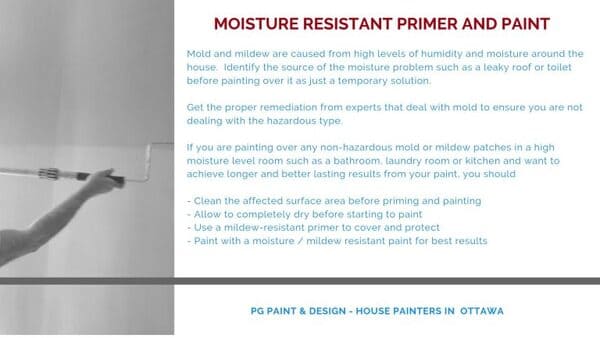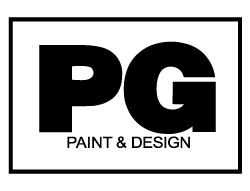While paint itself will not get rid of mold or mildew it is important to find the source of why and where the mold is coming from. Ignoring the issue of the root of the problem of finding out where the mold originates will only continue to cause you grief and even after failing to try to hide it by painting over it with a moisture resistant paint primer or other paint product, mold will continue to find its way back to the surface and continue to reappear.
By simply painting over it will not alleviate or rid you of the problem and painting any over mold or mildew should only be done after taking the necessary precautions and recommended steps to reduce your risk of mold and mildew health problems.
In this article we will help you learn to identify if you have mold or mildew problems in your home, the difference between mold and mildew, what the possible causes might be, and how to eliminate it and paint over it safely and prevent it from returning.
What is Mold
Mold is a type of fungus consisting of tiny organisms found almost everywhere. It can appear most often as as black, gray, or brown spots, but has also been known to show up as white, orange, green, or purple spots.
Mold thrives on moisture and spreads quickly creating spores that travel through the air which are easily inhaled and can cause breathing problems, headaches and fatigue, nausea and other health related issues.
What is Mildew
Mildew is also a form of fungus that is related to mold, the only difference between the two is how they appear. While mold tends to show up as a black or green large fuzzy type looking patch, mildew shows up as a gray or sometimes white patch on any moist area or surface like walls. Mildew can be treated with a good cleaning solution and some elbow grease and easily painted over with the right type of moisture resistant paints. You can read more about the differences in HGTV’s article mold vs. mildew.
Can You Paint Over Mold Or Mildew
In short the answer would be Yes. Mold or mildew should only be painted over after the necessary steps and precautions to eliminate the possible resurgence are done first. Find the source of where the moisture problems is coming from first.
Check the windows and doors from both the inside and the exterior for any leaks. Ensure you have no leaking faucets, bathtubs or toilets, and you can either check for yourself or hire a professional roofing company to ensure there is no damage to any part of your roof that could lead into water leaks and moisture buildup.
Make sure the high humidity level rooms have the proper ventilation. Install bathroom ceiling fans that vent outdoors and create indoor to outdoor air circulation. Make sure that the laundry room areas have good ventilation by installing dryer vents that go to the outside and make sure no leaks are present from the washer as well. It is recommended to use fans in the kitchen as well or at least a slightly opened window to allow good circulation of air flow and help prevent moisture buildup.
If you have not replaced your roof in over 20 years it would be advisable to look into having it redone. An older than 20-25 year roof could be a major culprit to having mold appear on the ceiling or walls of the interior of your home.
Once the source of the moisture problem has been identified and repaired, then there are ways to remove the mold and mildew stains.
Should You Paint Over Mold Or Mildew
Once the source of the high humidity or moisture levels inside your home are found you should identify whether the mold is of the hazardous or non-hazardous form. This is important to find out before considering to paint over it as paint products are not formulated to get rid of or kill any mold.
Painting in high humidity areas like bathrooms, kitchens, or laundry rooms with a mold and mildew resistant paint primer prevents the re-occurrence. You should only paint over any mold or mildew that is non-toxic.
There are plenty of paint products on the market that are specifically formulated to work best in high moisture level areas. Using the right types of primers, sealants and paints that are best suited for kitchens and bathrooms, laundry rooms and basements where moisture levels are usually high is your best first defence to avoid recurring mold and mildew problems.
By simply painting over it without taking care of removing it or eliminating it first will only continue to cause problems and eventually the mold spots will re-appear. If you paint over water damage for example you will only mask the problem temporarily because mold is a fungus and fungus loves humidity and moisture, it thrives on it and will continue to grow under the new paint.
What Causes Mold or Mildew Inside the House
Mildew can show up in rooms with high levels of humidity such as bathrooms, kitchens or basements and can appear as black, gray, green or brown spots. Areas in the home with high levels of humidity that are without proper or adequate fresh air circulation can eventually create mold or mildew problems.
To prevent mildew buildup ensure you create good air circulation within the home by installing bathroom vents that lead to the outdoors, replace air filters on furnaces and/or air conditioners at recommended intervals, open windows even slightly to allow some fresh air to circulate through the room. You should also make sure the proper ventilation is set up for any washers and dryers in any basement or laundry room.
Mold is typically caused by water leaks where the water infiltrates the drywall materials of the ceiling or walls and is left to sit and soak into the drywall for a long period of time.
Leaks are usually caused from leaks from a bathtub, a toilet, a water faucet or sink, a leaking roof or from flood damage. It is imperative to find the source of the water damage causing the mold and fixing it before it wreaks havoc on your home and your health.
Paint itself is not a cause of mold or mildew but the appearance of bubbling paint, peeling or cracking paint are usually signs that high levels of moisture are present and that immediate action should be taken.
By taking the first step to find the source of the problem will help identify the reasons why there may be moisture and the sooner the root of the problem is known the sooner the repair to fix it can occur.
To prevent mold and mildew damage make sure to seal any water leaks from any bathtub, toilets, water faucets or sinks. Repair any damage areas where leaks can happen in the roof so mold can be preventing from happening again.
Ignoring the main source of the where and why the moisture is coming from will only cause it to re-occur. Resolve it right the first time, by finding out where any water leaks are coming from and fixing them before just painting over it so that the mold and mildew problem can cease to exist.
How To Identify A Moisture Problem
Sometimes it is very obvious that mold is present from the dark spots on the walls, around the windows etc., other times you may not know for sure if it is mold or mildew. You can identify if you have a moisture problem inside your home if you notice any of the following issues:
Smell – If it smells musty and damp in the bathroom, laundry room or basement that can be a first indication that there may be a mold or mildew issue inside your home.
Seeing Spots – If you notice spotting on ceilings, walls or around the window frames or doors, this too can be a sign of mold growth. These spots may range in colour from white green, brown, gray and the most common of which is black.
Paint Problems – If there is a high level of moisture in a room you will notice paint bubbling which will lead to it peeling, cracking or flaking.
Bonus Tip: A quick way to find out if there is a moisture problem in your home apart from there being no visible spots or paint bubbles, is to simply press your hand on the area you believe a possibility of moisture exists and if the area feels wet, cooler or damp you may have a mold or mildew issue.
How To Get Rid Of Mold and Mildew
There are ways to remove mold with some household products or a try a simple test by spraying bleach on the affected surface area and if it fades or discolours it is most likely mildew.
After taking care of the source of the damage that created the mold and mildew and only if it is of the non-hazardous form should painting over mold or mildew be considered. It is merely a temporary fix if you haven’t taken care of the source and ensured the removal.
Mold will still be there after you paint over it if not properly tended to first. You will have difficulty applying the paint as well as the spots will eventually show up again. Painting over the mold will also continue to help the spores of the fungus spread and make them more air-borne around the entire home.
If the problem is larger than just simply being able to wash it off with bleach, priming it with a moisture resistant paint primer (link takes you to Kilz Paint products website) and sealing it with moisture resistant paint, (link takes you to benjamin moore paints website) then you should replace the drywall entirely and start with a clean slate. This of course is usually after you have called in the experts to identify the mold problem.
When To Call On Professionals
Painting over any mold or mildew is not recommended unless you have first identified the type of mold or mildew you may be dealing with. If unsure as to whether the mold inside your home is of the hazardous or non-hazardous form, you should consult with a mold expert in Ottawa.
Professional painting companies in Ottawa will have the experience and knowledge to recommend the right kinds of paints to use, if any drywall pieces need replacing or if a mold removal expert should be brought in.
If you are selling your home and there is a pre-existing mold issue be aware of the legal ramifications for not disclosing the problem. New home buyers can hold the owner as well as any painting contractor or Ottawa real estate agent you may have hired.
It is not recommended that you just paint over it and hide it to conceal it from potential home buyers. You should fully disclose the problem to alleviate the headaches of having to deal with the additional costs that would arise from non-disclosure.
By not disclosing the mold problem you may face the additional costs of legal fees, costs of repairs and damages created from the mold issue and you could even potentially face personal damage costs incurred if a legal suit is brought forward.
If you feel uncertain as to whether you can or should tackle painting over mold and mildew issues feel free to reach out to a painting professional you can trust.
This post was originally published on Jul 8, 2019 and edited on May 02, 2021
